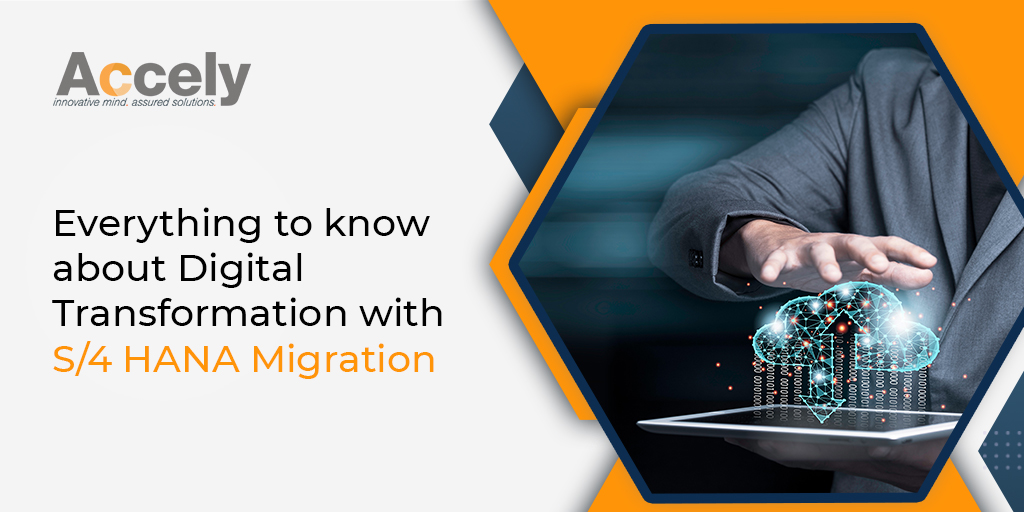Everything to know about Digital Transformation with S/4 HANA Migration
06-Apr-2021The advancement of technology has propelled businesses in a manner that they are developing a more efficient execution of strategy and planning. With companies of varied shapes and sizes jumping into the SAP bandwagon, the S/4 HANA is shaping the journey of digital transformation.
If you are one of those tech-savvy companies that are looking at embracing innovation that the S/4 HANA Cloud platform can provide, you are already planning your SAP S/4 HANA Migration ahead of the 2025 deadline.
As we all know, SAP will stop supporting and enhancing its SAP ECC 6.0 Version by 2025. Even so, many organizations are confused about the methodology to choose for SAP S4 HANA Migration Implementation as changing the core functions of an organization is not so easy. The migration of a legacy system into the new ecosystem requires deep knowledge and experience for preparing, executing and supervising projects.
We understand the concerns around paving a pathway to digital transformation. Therefore, to help you out with a seamless SAP S/4 HANA Migration experience, we have made this blog that walks you through a roadmap to the HANA migration. Keep reading to know more…
Pathway to SAP S4 HANA Implementation
Step 1: Explore
The first step to your SAP S/4 HANA Migration involves understanding all the possible Business Scenario Recommendations (BSR), where you can review all the possible options for your migration journey. When you prepare for your migration journey, you come across the three possible modes of switching to SAPs latest platform, they are:
- Brownfield: This approach towards the SAP migration allows you to integrate the S/4 HANA into your ecosystem without re-implementing your existing core functions. Here, you can easily migrate without disrupting the flow of your existing business processes. With Brownfield migration; which is also known as platform migration; most of your business functions are retained without losing your previous workflow, logic, etc.
- Greenfield: The second migration option, refers to the migration technique where you develop your infrastructure from scratch. With this Greenfield approach, everything from operating systems, data, and applications are implemented to suit your core business processes and needs. This way you are assured that you are going into a new system to take full advantage of the innovations without any worry of carrying forward legacy problems.
- Bluefield: Bluefield or the hybrid approach is one of the most effective options that enable a seamless migration experience for organizations that function with complicated frameworks. With the Bluefield approach, you can retain parts of your digital ecosystem while upgrading them to ensure real-time integration with the new SAP S/4 HANA Cloud Platform. This approach has data relevancy that is pre-defined, saving you time, efforts, and cost of migration.
Once the migration approach is finalized, it’s time to meet your SAP partner that will help you develop a detailed project and execution plan for transition.
Step 2: Prepare Your Data for Migration
The second step takes effect, post the overview process. In this step, you meet your Expert-guided planning (EGP), where the SAP S/4 HANA implementation will commence. SAPs data platform allows you to tap into a simplified data model making it easier for you to integrate your data from your legacy systems. Whether you retain parts of your database or go for a completely new implementation, you need to consult with your SAP expert to discuss the SAP HANA size and clean your system before the process.
Step 3: Realize and Plan the Deployment Process
Once you have prepared your data with the initial stages of migration, it’s time for you to avail the chosen partners Expert Guided Implementation (EGI) for experiencing the new platform including enhancements like SAP Fiori, IoT, Blockchain, etc. However, the roadmap to migration would also depend on the SAP platform’s customer experience. Here, your SAP partner will help you by creating different test systems and prototypes, allowing you to experience the new system and give early feedback over the cloud.
Step 4: Deploy Your HANA Migration
Once you have done the above steps, it’s time to deploy the SAP S/4 HANA. After this is done, your newly deployed system undergoes CQC (Continuous Quality Checks) for support without any gap so that the identified new business processes are working smoothly and are bug-free. Post completion of the quality check process thoroughly, it’s time to start using the new version and looking at the SAP Enterprise Support report to fully utilize the newly integrated platform’s advantages into your new ecosystem.
Re-imagine Your Business Like Never Before!
SAP S/4 HANA implementation unlocks the door to a new world with your new business process. Once your road to migration is complete, it’s time to reap the benefits of the new system. Some of the core benefits of migrating to SAP S/4 HANA Cloud Platform are:
- Improved innovation and capabilities via a digital core, reliable enough to manage complex scenarios.
- Improved analytics for real-time decision-making.
- Automation of processes with minimal manual intervention, saving you resources for your core business functions.
- Boost your digital growth with a transformation journey that is connected over the cloud.
Conclusion
Once you have completed your SAP S/4 HANA migration journey, it’s time to enjoy the benefits. However, a word of caution, remember the SAP S/4 HANA Cloud Platform migration approach is not a one-size-fits-all solution; it has to be based on your current needs and feature vision. Choose your approach accordingly!












